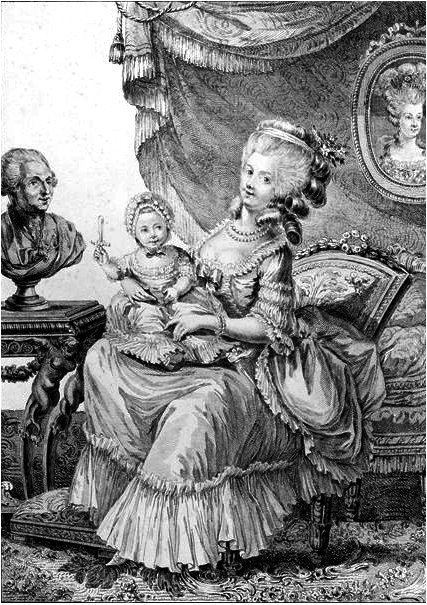Father Charles de Rohan Mother Anne Therese of Savoy | Name Victoire Rohan | |
 | ||
IssueDetail Charles Alain, Prince of GuemeneMarie Louise Josephine, Princess of RochefortLouis Victor, Duke of Bouillon Spouse Henri Louis, Prince of Guemene (m. 1761) Children Charles Alain, Prince of Guemene Parents Princess Anne Therese of Savoy, Charles, Prince of Soubise Grandparents Maria Vittoria of Savoy, Anne Julie de Melun, Victor Amadeus I, Prince of Carignano, Jules, Prince of Soubise Great-grandparents Victor Amadeus II of Sardinia | ||
Victoire de Rohan, Princess of Guéméné (Victoire Armande Josèphe; 28 December 1743 – 20 September 1807) was a French aristocrat and court official. She was the governess of the children of Louis XVI of France. She is known better as Madame de Guéméné. She was Lady of Clisson in her own right.
Contents
Biography
Victoire Armande Josèphe de Rohan was the second daughter of Charles de Rohan, Prince of Soubise. The Princes of Soubise were a cadet branch of the House of Rohan. Her mother was Princess Anna Teresa of Savoy, a daughter of Victor Amadeus, Prince of Carignano. Her mother was also a first cousin of Louis XV through an illegitimate line. She had an older half-sister, Charlotte de Rohan, who married in 1753 Louis Joseph de Bourbon, prince de Condé. As the princesse de Condé, Charlotte was a princesse du sang and far outranked her younger half-sister.
As the House of Rohan claimed descent from the medieval Dukes of Brittany, its members were treated at court as princes étrangers with the style of Highness.
Marriage
At the age of seventeen, Victoire married her cousin, Henri Louis de Rohan, duc de Montbazon, who was fifteen at the time. He was a member of the main House of Rohan, the Princes of Guéméné. He was a nephew of the cardinal de Rohan, who was disgraced in the famous Affair of the Diamond Necklace involving Marie Antoinette. Henri Louis eventually became the Grand Chamberlain of France. The couple had five children.
Upon the death of his father in 1788, the duke inherited the title of prince de Guéméné. Afterwards, Victoire was known at court as Madame de Guéméné. At the death of her father, her spouse became the legal heir to the title Prince of Soubise. She and her family lived lavishly in Paris at the Hôtel de Rohan-Guéméné, located on the famous Place des Vosges at number 6.
Courtier
In 1775, Marie Louise de Lorraine, comtesse de Marsan resigned the post of governess to the royal children in favour of Victoire, who was her niece. From 1778 to 1782, Victoire was in charge of the household of King Louis XVI's oldest child, Marie Thérèse of France, known at court as Madame Royale. In this role, she was in charge of a staff of over one hundred courtiers and servants.
During her tenure as royal governess, she was in accordance with her position not allowed to leave court except with a written permission from the monarch, a permission she asked only to attend the parties of the archbishop of Narbonne at Hautefontaine. She became an influential personal friend of queen Marie Antoinette, and was alleged to have had a bad influence upon her, mainly by introducing her to wasteful and expensive habits such as arranging illegal games with high stakes, particularly pharaoh, which she introduced in her salon at Versailles, and the new English fashion of horse races, interests which made the queen acquire huge debts.
She had a relationship with Augustin Gabriel de Franquetot de Coigny, comte de Coigny' (1740 - 1817), the father of one of her charges, Aimée de Franquetot de Coigny, duchesse de Fleury (1769 - 1820), muse of the poet André Chénier. The prince de Guéméné meanwhile had an affair with Victoire's close friend, Thérèse Lucy de Dillon, comtesse de Dillon. Because of this, Abbé de Vermond reportedly reproached Marie Antoinette from keeping company with women of ill repute like Dillon and Guéméné. In 1776 emperor Joseph, during his stay in France, reproached his sister queen Marie Antoinette for attending the salon of the princesse, which he called a gambling den.
She was described as intelligent and with an interest in spiritualism: "though endowed with considerable intellectual power, spent her time in pursuing the follies of spiritualism", and in possession of a large collection of famous jewels, which she seldom wore but regularly lend to others and was therefore often seen at state occasions.
In 1782, Victoire was forced to resign her post due to a scandal created by her husband's mounting debt of 33 million livres, a debt that eventually, in 1797, led to the sale of the Hôtel de Rohan-Guémené. Queen Marie Antoinette did secure a pension for Victoire for her service at court, but the couple was banned from court and the friendship between the queen and Victoire was discontinued.
Later life
After the bankruptcy, which was viewed as a scandal, the couple was more or less ostracized from society, and Victoire lived at a palace provided by her father; she was regarded to bear the scandal with dignity. Victoire and her spouse lived to see the French Revolution in 1789, later fleeing to Austria. They eventually settled in Bohemia. They lived at Sychrov Castle, and it was here that the Rohan Family lived for 125 years.
Victoire died in Paris in September 1807 at the age of sixty-three. Her widower outlived her by two years.
